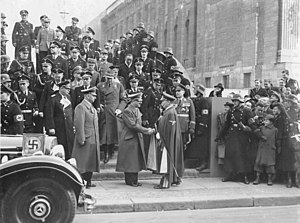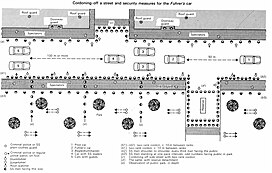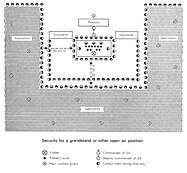
Ernst Kaltenbrunner was a high-ranking Austrian SS official during the Nazi era and a major perpetrator of the Holocaust. After the assassination of Reinhard Heydrich in 1942, and a brief period under Heinrich Himmler, Kaltenbrunner was the third Chief of the Reich Security Main Office (RSHA), which included the offices of Gestapo, Kripo and SD, from January 1943 until the end of World War II in Europe.

The Geheime Staatspolizei, abbreviated Gestapo, was the official secret police of Nazi Germany and in German-occupied Europe.

Heinrich Luitpold Himmler was a German politician who was the 4th Reichsführer of the Schutzstaffel, a leading member of the Nazi Party of Germany, and one of the most powerful men in Nazi Germany, primarily known for being a main architect of the Holocaust.

Reinhard Tristan Eugen Heydrich was a high-ranking German SS and police official during the Nazi era and a principal architect of the Holocaust.

The Schutzstaffel was a major paramilitary organisation under Adolf Hitler and the Nazi Party in Nazi Germany, and later throughout German-occupied Europe during World War II.
Sicherheitsdienst, full title Sicherheitsdienst des Reichsführers-SS, or SD, was the intelligence agency of the SS and the Nazi Party in Nazi Germany. Established in 1931, the SD was the first Nazi intelligence organization and the Gestapo was considered its sister organization through the integration of SS members and operational procedures. The SD was administered as an independent SS office between 1933 and 1939. That year, the SD was transferred over to the Reich Security Main Office, as one of its seven departments. Its first director, Reinhard Heydrich, intended for the SD to bring every single individual within the Third Reich's reach under "continuous supervision".
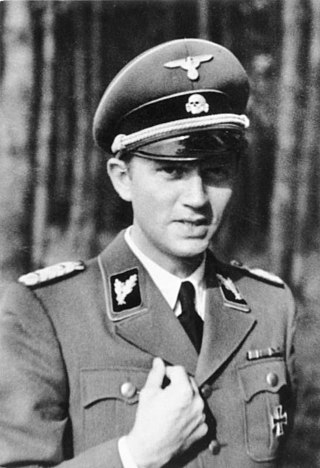
Walter Friedrich Schellenberg was a German SS functionary during the Nazi era. He rose through the ranks of the SS, becoming one of the highest ranking men in the Sicherheitsdienst (SD) and eventually assumed the position as head of foreign intelligence for Nazi Germany following the abolition of the Abwehr in 1944.

The Reich Security Main Office was an organization under Heinrich Himmler in his dual capacity as Chef der Deutschen Polizei and Reichsführer-SS, the head of the Nazi Party's Schutzstaffel (SS). The organization's stated duty was to fight all "enemies of the Reich" inside and outside the borders of Nazi Germany.

Reichsführer-SS was a special title and rank that existed between the years of 1925 and 1945 for the commander of the Schutzstaffel (SS). Reichsführer-SS was a title from 1925 to 1933, and from 1934 to 1945 it was the highest rank of the SS. The longest-serving and most noteworthy office holder was Heinrich Himmler.
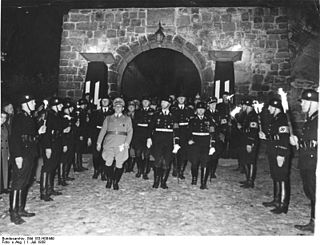
The Allgemeine SS was a major branch of the Schutzstaffel (SS) paramilitary forces of Nazi Germany; it was managed by the SS Main Office (SS-Hauptamt). The Allgemeine SS was officially established in the autumn of 1934 to distinguish its members from the SS-Verfügungstruppe, which later became the Waffen-SS, and the SS-Totenkopfverbände, which were in charge of the Nazi concentration camps and extermination camps. SS formations committed many war crimes against civilians and allied servicemen.
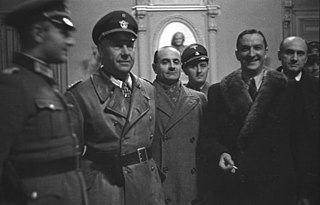
The Sicherheitspolizei, often abbreviated as SiPo, was a term used in Germany for security police. In the Nazi era, it referred to the state political and criminal investigation security agencies. It was made up by the combined forces of the Gestapo and the Kriminalpolizei between 1936 and 1939. As a formal agency, the SiPo was incorporated into the Reich Security Main Office (RSHA) in 1939, but the term continued to be used informally until the end of World War II in Europe.

Julius Schreck was an early senior Nazi official and close confidant of Adolf Hitler.
There were two main Police forces of Nazi Germany under the Reichsführer-SS, Heinrich Himmler from 1936:
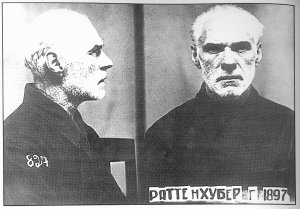
Johann Rattenhuber, also known as Hans Rattenhuber, was a German police and SS general. Rattenhuber was the head of German dictator Adolf Hitler's personal Reichssicherheitsdienst bodyguard from 1933 to 1945. In January 1942, Rattenhuber's RSD units participated in the mass shooting of 227 Jews at Strizhavka. After the war, he was released from a Soviet prison on 10 October 1955 and allowed to go to West Germany. He died in Munich in 1957.

The Reichssicherheitsdienst was an SS security force of Nazi Germany. Originally bodyguards for Adolf Hitler, it later provided men for the protection of other high-ranking leaders of the Nazi regime. The group, although similar in name, was completely separate from the Sicherheitsdienst (SD), which was the formal intelligence service for the SS, the Nazi Party and later Nazi Germany.
Hauptamt Sicherheitspolizei was a central state police agency command office in Nazi Germany entrusted with overseeing the Kriminalpolizei and the Geheime Staatspolizei for the years 1936–1939.

SS-Begleitkommando des Führers, later known as the Führerbegleitkommando, was originally an eight-man SS squad formed from a twelve-man security squad tasked with protecting the life of Adolf Hitler during the early 1930s. Another bodyguard unit, the Reichssicherheitsdienst was formed 1933, and by the following year replaced the FBK in providing Hitler's overall security throughout Germany. The FBK continued under separate command from the RSD and provided close, personal security for Hitler. The two units worked together for Hitler's security and protection, especially during trips and public events, though they operated at such events as separate groups and used separate vehicles. When the FBK unit was expanded, the additional officers and men were selected from the Leibstandarte SS Adolf Hitler (LSSAH). The majority of these additional men were used by Hitler as guards for his residences while uninhabited and as orderlies, valets, waiters, and couriers.

The government of Nazi Germany was a totalitarian dictatorship governed by Adolf Hitler and the Nazi Party according to the Führerprinzip. Nazi Germany was established in January 1933 with the appointment of Adolf Hitler as Chancellor of Germany, followed by suspension of basic rights with the Reichstag Fire Decree and the Enabling Act which gave Hitler's regime the power to pass and enforce laws without the involvement of the Reichstag or German president, and de facto ended with Germany's surrender in World War II on 8 May 1945 and de jure ended with the Berlin Declaration on 5 June 1945.

Bruno Gesche rose to the rank of Obersturmbannführer in the SS in Nazi Germany. He was a member of Adolf Hitler's entourage and the fourth commander of Hitler's personal bodyguard for the periods June 1934 – April 1942 and December 1942 – December 1944.
Kriminalpolizei, often abbreviated as Kripo, is the German name for a criminal investigation department. This article deals with the agency during the Nazi era.
